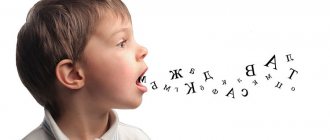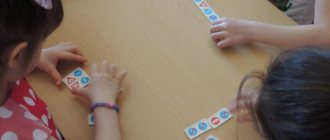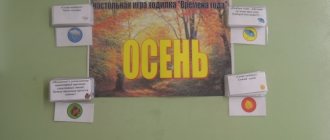Didactic game "Autumn"
Didactic game “Number. Sign. Subject" on the lexical topic "Autumn"
The game is intended for children aged 4-6 years with severe speech impairments, as well as for children of preschool and primary school age to develop the lexical and grammatical structure of speech.
Didactic game “Number. Sign. Subject" can be used both in individual and subgroup lessons with children.
Target:
This set of games will help an adult teach a child:
- agree nouns with numerals and adjectives in gender, number, and case.
- select qualitative, relative, possessive adjectives for nouns.
- use ordinal numbers in speech, coordinate them with nouns and adjectives in gender, number, case.
- activate mental activity, associative thinking;
- make comparative sentences with the conjunction “a”.
Material for the game:
cards with game tasks in two subjects of the same lexical group; playing field and cut cards for independent selection and compilation of a plot series; sets of numbers.
Game description:
Game with ready-made models: each table contains tasks for two subjects of the same lexical group for a larger educational load. At the beginning of the game, the child needs to be clearly shown how associations can be used to indicate the characteristics of objects. For example, how can you depict a bitter taste, show the hardness, softness, juiciness of vegetables, color and shape.
Below are ready-made game cards:
- two oval deep puddles;
- six large cold drops;
- one round cold sun;
- five short cold autumn days;
- two autumn cold rains;
- seven autumn cold winds;
- one autumn mahogany;
- four autumn blue clouds.
The game requires compliance with the following steps:
- Name a word denoting a number (what number? - one).
- Name a word denoting an object (what is it? - tree).
- Agree the noun with the numeral in gender (how many trees? - three is one).
- Name the words denoting the attribute of an object, coordinate them with numerals and nouns in gender, number (one tree (which?) - red in autumn).
- Agree the numeral with the adjectives and nouns in gender and number. (Say in a complete sentence, starting with a number. – One autumn red tree.)
- Using the same principle, consider another subject of the lexical group - a cloud.
- Make comparative sentences with the conjunction “a”. (There is one tree, and there are four clouds. The tree is red, and the cloud is blue.)
Game with cut cards : played on the same principle as with ready-made models. Only here the child takes an active position and is given more independence.
First, you should invite the child to choose an item on a lexical topic and place it in a sector with an asterisk, then a number (place in the first sector) and select adjectives in the form of picture symbols (place in the longest sector of the playing field). The symbol pictures are first reviewed and what they mean is explained.
To better understand the progress of the game with cut cards, a sample is provided below.
Using the didactic game “Number. Sign. Subject" children will quickly master the skills of agreeing adjectives, nouns and numerals in gender, number, case; will learn to select adjectives for nouns and develop their associative thinking.
The development of associative thinking has a positive effect on the process of memorizing and reproducing necessary information.
On our website you can find other educational games from the “Number” series. Sign. Item". To do this, follow the highlighted link .
We wish everyone success.
Didactic game: “Autumn Adventure”, for children 4 - 7 years old
Author:Lyanguzova Olga Zhanovna
Position:
teacher - speech therapist
Place of work:
MKDOU No. 18, Miass, Chelyabinsk region
Purpose of the material:
the game can be used by specialists in working with preschool children aged 4 - 7 years, including for children with disabilities.
Equipment:
1 playing field, 9 pictures of leaves, 9 pictures of trees.
Goal:
development of observation, visual attention and memory
Objectives:
1. Activate children’s knowledge on the topic: “Autumn. Trees in autumn"
2. Develop the ability to form relative adjectives, develop basic mental processes.
3. Develop the ability to obey the rules of the game and play in a group of peers.
Form of organization:
individual or subgroup (2-3 people)
Preliminary work:
familiarization with the image of leaves and trees.
Progress of the game:
1 option
In front of the children there is a playing field of 9 sectors. Each sector contains 3 pictures depicting autumn leaves (chestnut leaf, oak leaf, willow leaf, aspen leaf, linden leaf, poplar leaf, rowan leaf, maple leaf, birch leaf).
The first move is determined by the counting rhyme:
"One two three four five.
We will collect leaves.
If you find a leaf,
I went first and played.”
If 3 children are playing, then each is given 3 pictures depicting single leaves.
The first player examines his leaves and the first sector on the playing field, if he finds among his leaves a similar one on the field, then he closes the sector with it and correctly names the leaf (chestnut leaf). Then considers the next sector. If the required sheet is not available, then the turn passes to the next player.
If there are 2 children playing, then we distribute 3 pictures to each and put 3 next to each other in a pile (with their shirts up) - “on the path.” The game is similar, but if the required sheet is not available, then it must be taken from the path. Only after this the turn passes to the other player.
The players' task is to get rid of their cards as quickly as possible.
The adult monitors the correct completion of the task and the formation of relative adjectives, correcting if necessary. If the child does not form the word correctly, he must stop and repeat the adjective correctly 3 to 5 times (maple, maple, maple)
Option 2
The game is played similarly to the previous one, with the only difference, instead of leaves, children are offered with images of trees. Thus, the task becomes more difficult, since children need to determine which tree the leaf comes from. In this version of the game, the child points to a leaf and introduces a relative adjective into the sentence: “A willow leaf from a willow tree.”
Making the game:
Word.
The picture material is taken from the Internet (links from sources are located below).
In the search engine we type the word CLIPART (picture on a transparent background) and the name of the picture. Select the required image, copy and paste it into the document. To remove the background, perform the following steps: WORK WITH THE DRAWING - REPAINT - SET A TRANSPARENT BACKGROUND.
So that the picture can easily move on the sheet, you need to click on the right mouse button, select OBJECT FORMAT - TEXT WRAP - BEFORE TEXT. The entire material can be downloaded from the “Download” link.






